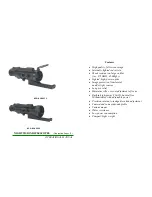
6
Using Your Telescope:
After you have aligned your viewfinder, you are ready to start observing! Put the 26mm eyepiece into the focuser to get
the widest field of view. This wider field of view will make it easier to locate and track objects. Use the panhandle to
move the scope up, down and side to side until your target comes into view in the eyepiece. It is important to remember
that the rotation of the Earth means objects will move out of your eyepiece fairly quickly. Once you have found and
focused on your desired target, you can track it as it journeys across the night sky using the panhandle.
To get a closer look at an object, take out the 26mm eyepiece and replace it with the 9.7mm eyepiece. This will increase
the magnification to 51.5x. For the strongest magnification, take out the 9.7mm eyepiece and insert the 2x Barlow lens
into the focuser. Put the 9.7mm eyepiece into the Barlow lens and secure it in place, this will up the magnification from
51.5x to 103x. If you use the Barlow lens with the 26 mm eyepiece, the magnification will change from 19x to 38x.
Note: This telescope is designed for astronomical
use. Terrestrial objects may appear inverted,
sideways or at an angle depending on how your
tube is oriented due to optical design. This
rotation is perfectly normal on all Newtonian
reflectors and will not affect astronomical
viewing.
Cleaning:
The internal optics of your reflector telescope will rarely requiring cleaning as long as you put the dust cover on when
the device is not in use. Small particles of dust that may enter the optical tube assembly during an observing session
should not impact image quality. In the rare circumstance that a film of dirt collects on either mirror, you will need to
contact Customer Service at (866) 252-3811 or service@explorescientific.com to arrange for the device to be returned to
our facility for disassembly, cleaning and collimation. Although the optics inside of the reflector will likely never require
cleaning as long as the dust cover is on when the telescope is not in use, eyepieces will need to be kept free of dust and
dirt. To clean the eyepiece, use only a photo-grade soft brush or a lint-free cloth to gently remove any particles from the
lens. Do not press down hard while cleaning as this might scratch the lens. If the eyepiece lens is exceptionally dirty, it
may be necessary to dampen a lint-free cleaning cloth with an optical glass cleaning fluid and then wipe the lens clean
using very light pressure.
The eyepiece is NOT waterproof so do not spray fluids directly onto the glass or dip it in
water. Never use harsh detergents! After you have finished cleaning an eyepiece, allow it to fully dry before storing.
Troubleshooting Guide:
Problem
Solution
No picture
Remove dust protection cap.
Blurred picture
Adjust focus using focus wheel.
No focus possible
Wait for temperature to balance out.
Bad quality
Never observe through a glass surface such as a window.
Viewing object visible in the finder, but
not through the telescope
Align finder to telescope (see instructions)
Focal Length Eyepiece
Magnification
2x Barlow Lens
500mm
26mm
19x
38x
500mm
9.7mm
51.5x
103x
Summary of Contents for 80-30114
Page 14: ...14 Notes...
Page 15: ...15 Notes...
























